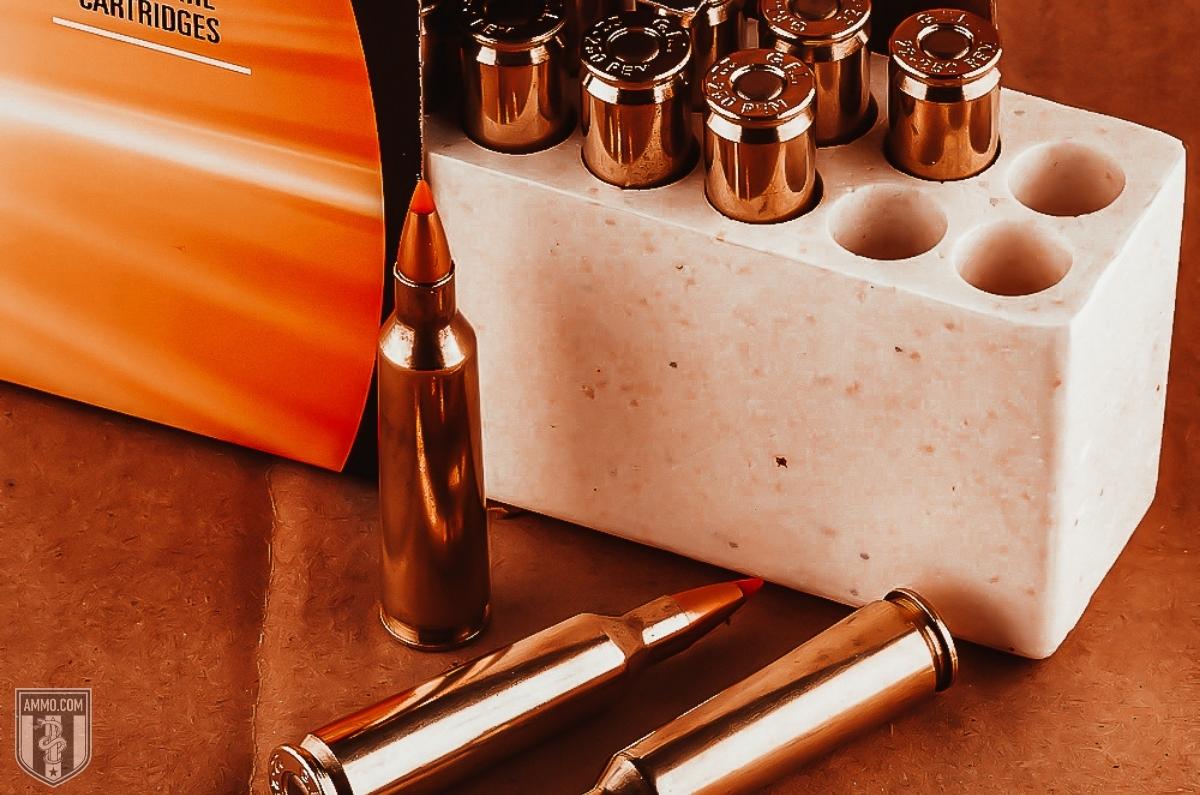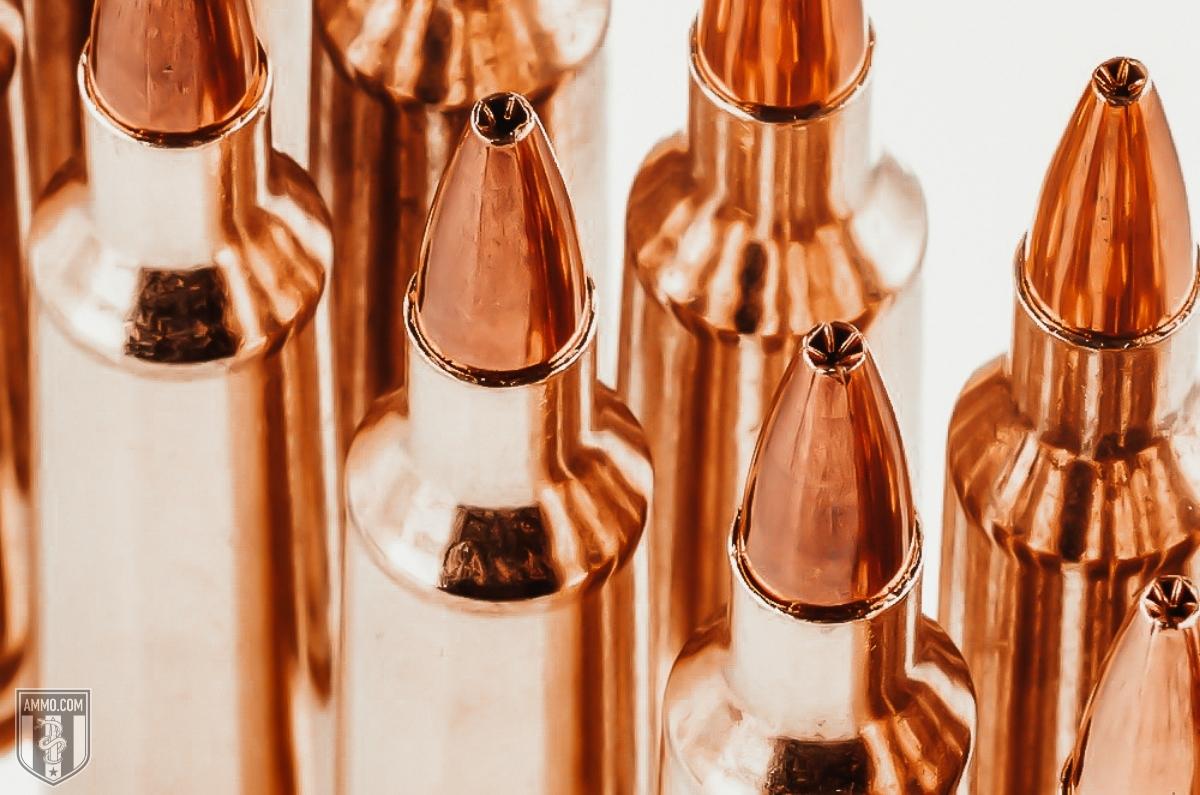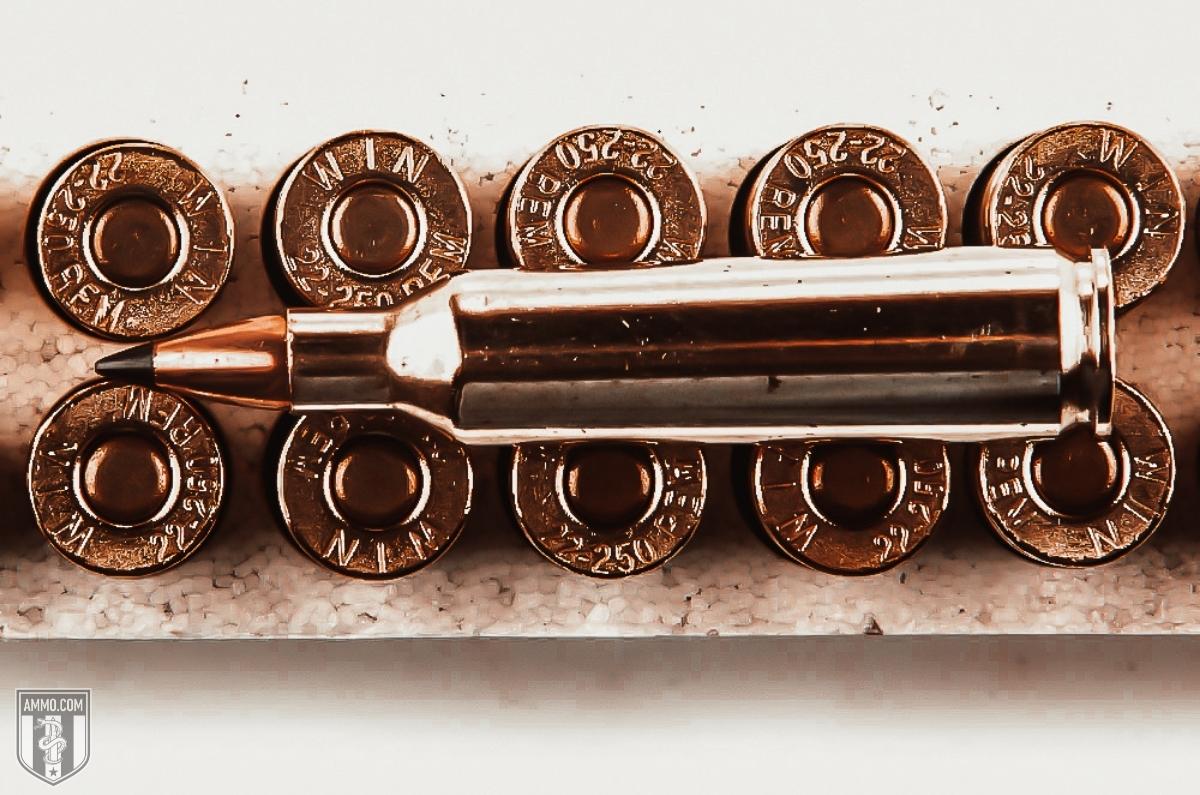22 Nosler vs 22 250: 22 Caliber Speed Demons
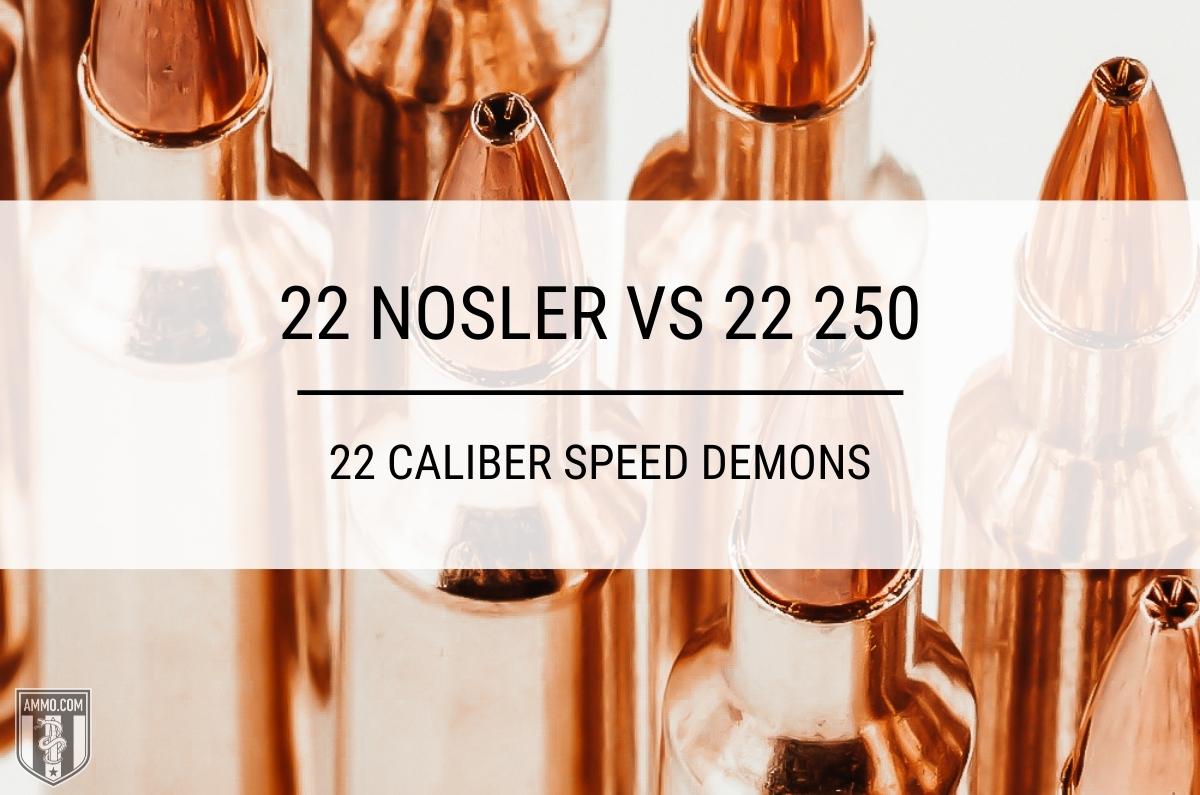
The 22 Nosler and 22-250 Remington are two 22 caliber centerfire cartridges that excel at varmint hunting.
Many shooters would agree that the 22-250 is the uncontested king of the vermin slayers not named 223 Remington. With its flat trajectory and blistering high muzzle velocities, the 22 250 has been the gold standard for varmint cartridges since its introduction in the 1930’s.
Although the 22-250 is a great cartridge, it is not well suited for semi-automatic fire. Although some shooters might contest that you do not need semi-auto for varmint hunting, follow-up shots and multiple target engagements can occur if you pull in multiple coyotes on your call.
Enter the 22 Nosler, a new cartridge with one goal in mind: the push the limits of the 22-caliber bullet in the AR-15 with minimal modifications to the rifle.
In this article, we will evaluate the 22 Nosler vs 22-250 Remington to help you understand the differences between the two and give you a clearer idea of which cartridge is best for your shooting needs.
What is the difference between 22 Nosler and 22 250?
The difference between 22 Nosler and 22 250 is that the 22 250 has a higher case capacity and will outperform the 22 Nosler in terms of ballistics. However, the 22 Nosler is designed to be fired from the semi-automatic AR-15 rifle while the 22-250 Remington is typically fired from bolt-action rifles.
Cartridge Specs
When evaluating centerfire rifle cartridges, it’s a good idea to analyze the cartridge specs to gain more knowledge of each.
One major difference between these two cartridges is how they were developed.
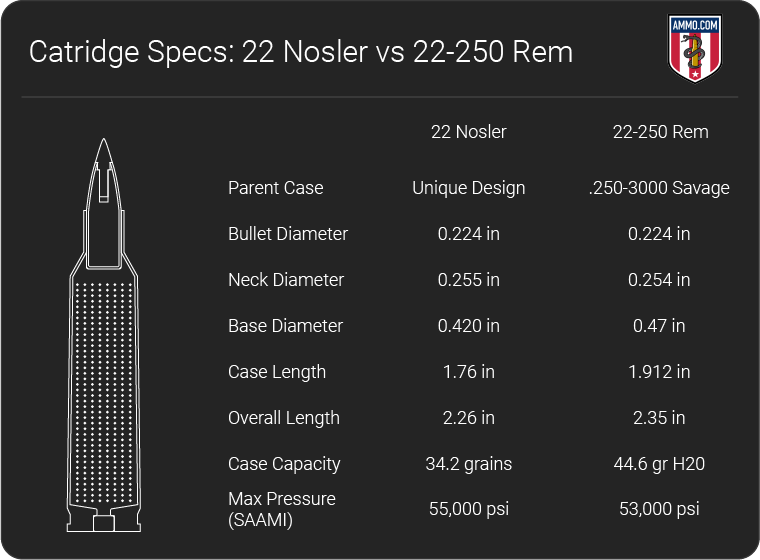
Like many cartridges of the early 20th Century, the 22-250 began its life as a wildcat cartridge known as the 22 Varminter. Gunsmiths of the 1930’s created the cartridge by necking down the .250-3000 Savage to accept 22 caliber bullets.
The 22 Nosler, on the other hand, is a relatively new cartridge as it was introduced at SHOT Show 2017. Unlike the 22-250, the 22 Nosler has no parent cartridge and was designed from the ground up to push the limits of 22 caliber bullets in the AR-15.
One difference that might not be detectable to most shooters is that the Nosler has its shoulders set back further than the 223 Rem. This is a safety measure to prevent a 223 Remington/5.56 NATO round from being chambered in a 22 Nosler barrel.
Both rifle cartridges fire the same diameter bullets at 0.224”. As such, their neck diameter is also identical.
The 22 250 is a rimless design while the 22 Nosler has a rebated rim, meaning the rim is narrower than the cartridge base. Although the 22 Nosler has a base diameter of 0.420”, its rim diameter measures 0.378” which means that it will use the same bolt face as the 223 Rem/5.56 NATO in the AR-15.
When you look at these cartridges side-by-side, you can tell that the 22-250 has a longer case length and is a wider cartridge in general. The 22-250 case stands 1.912” tall compared to 1.76” for the shorter Nosler cartridge. The trend continues with overall length, as the 22-250 is the longer of the two at 2.35” compared to 2.26” for the 22 Nosler. Coincidently, the maximum overall length acceptable for the AR-15 chamber is 2.26”.
With a larger case comes more case capacity, and the 22-250 can hold a whopping 44.6 gr compared to 34.2 gr for the 22 Nosler. This increased case capacity will generally allow the 22-250 to achieve higher velocities.
The final difference between these two centerfire cartridges is the maximum overall chamber pressures. The 22 Nosler can withstand slightly higher pressure loads at 55,000 psi per SAAMI specs compared to 53,000 psi for the 22-250.
Recoil
The 22 Nosler will generally have less recoil than the 22-250, however most shooters consider both cartridges as having mild recoil.
Recoil is an important consideration when purchasing a new rifle as a round with heavy recoil will be more difficult to control and will slow your rate of follow up shots.
Recoil is affected primarily by muzzle velocity (FPS), powder charge, bullet weight, and rifle weight.
For this comparison we will consider two 55 grain Nosler Ballistic Tip bullets for each cartridge, with the 22-250 load traveling at 3,700 fps and the 22 Nosler at 3,500 fps. Assuming a 7-pound rifle, the 22-250 will have a free recoil energy of 6.72 ft-lbs compared to 5.8 ft-lbs for the 22 Nosler.
Both 22 caliber cartridges have very low recoil compared to their muzzle velocities, and only the most recoil sensitive shooters will be able to discern much of a difference between the two of them. However, for those extremely recoil sensitive shooters, the 22 Nosler is the better choice.
Barrel Twist Rate and Barrel Life

One of the downsides to the 22-250 is rifles typically come with slower twist rates. Typically, 22-250 rifles are delivered from the factory with a 1:12 or even 1:14 twist barrel. These slower twist barrels are great for stabilizing lower weight 22 caliber bullets, but these bullets are more susceptible to wind drift which is important when shooting long-range.
The 22 Nosler, on the other hand, generally comes with a 1:8 twist barrel. This faster twist rate is typical for the AR-15 platform and has been shown to easily stabilize bullets 55 grains in weight and higher. These heavier bullets will generally resist wind drift more effectively than lighter ones and gives hunters more versatility in the type of bullets they can fire.
The other issue to consider is barrel life, as both rounds are known for being tough on barrels. The Nosler website suggests that barrels should be changed around 2000-4000 rounds, which is typical for high velocity rounds like the 220 Swift.
Shooting forums and competitive shooters also report similar results for the 22-250, that peak accuracy begins to fall off around 2,000 rounds.
Muzzle Velocity, Kinetic Energy, and Trajectory
For this comparison we will analyze three factory loads for the 22-250, the Nosler Varmint 40 grain Ballistic Tip, the Sierra Prairie Enemy 50 gr BlitzKing, and the Hornady 55 gr V-MAX. For the 22 Nosler we will compare the Nosler Ballistic Tip 55-grain bullet and the Nosler RDF 85 gr HPBT Match.
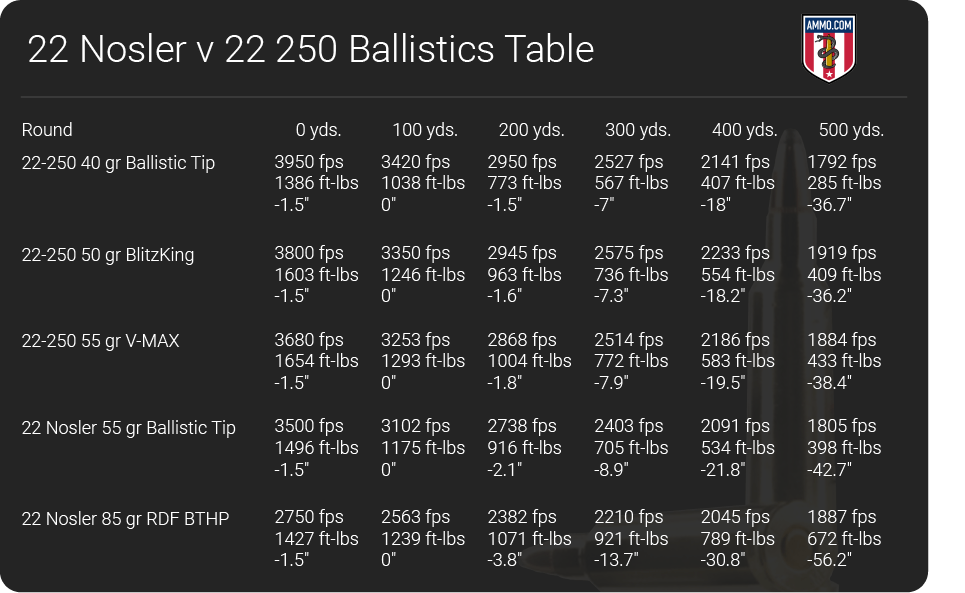
It’s no surprise that the 22-250 dominates in terms of muzzle velocity for all loads. The fastest factory load being the 40 gr Nosler Ballistic Tip at 3,950 fps with the Sierra 50 gr and Hornady 22-250 ammo (55 gr bullets) coming in at 3,800 fps and 3,680 fps, respectively.
Due to its lower case capacity, the 22 Nosler bullets have lower muzzle velocities at 3,500 fps and 2,750 fps for the 55 gr and 85 gr loads, respectively.
For kinetic energy, the heavier bullets fired by the 22-250 at higher velocities will generally have more energy at the muzzle. However, the heavier bullets fired by the 22 Nosler can sustain their kinetic energy over distance more efficiently than the lighter bullets fired by the 22-250.
For example, the 85 gr RDF BTHP Match bullet fired by the 22 Nosler maintains approximately 50% more kinetic energy at 500 yards than the 50 and 55-grain bullets fired by the 22-250 (672 ft-lbs vs ~410 ft-lbs).
In terms of trajectory, it is not surprising that the 22-250 has a flatter trajectory than the 22 Nosler. In fact, all three loads for the 22-250 Rem fall within a 2” spread at 500 yards (-36.2 to -38.4”), making it an excellent long-range shooting cartridge.
The 22 Nosler is no slouch in terms of trajectory, as the 55-grain bullets for both the Nosler and 22-250 are within 4” of each other at 500 yards. The 85-gr bullet has the most arcing trajectory at 500 yards with -56.2” of bullet drop.
There’s no denying that the 22 250 ballistics are superior to 22 Nosler ballistics, however this was not entirely unexpected as the 22-250 has a 30% advantage in powder capacity over the 22 Nosler. That being said, the 22-250 is only slightly favored over the 22 Nosler when comparing similar bullet weights as evidenced by the two 55-grain loads for each.
Ballistic Coefficient and Sectional Density
The 22 Nosler will generally have a higher ballistic coefficient and sectional density for heavier 22 caliber bullets.
Ballistic coefficient (BC) is a measure of how aerodynamic a bullet is and how well it will resist wind drift. Sectional density (SD) is a way to evaluate the penetration ability of a bullet based on its external dimensions, design, and weight.
As both cartridges fire the same 22 caliber bullets, there is little to no difference in ballistic coefficient for bullets of similar weight and design. However, as the 22 Nosler is capable of firing heavier bullets, these offerings will have a higher BC.
The ballistic coefficient for 55 grain bullets like the V-MAX and Ballistic Tip measures around 0.24. Heavy bullets like the Nosler 85 gr RDF have a higher BC around 0.498.
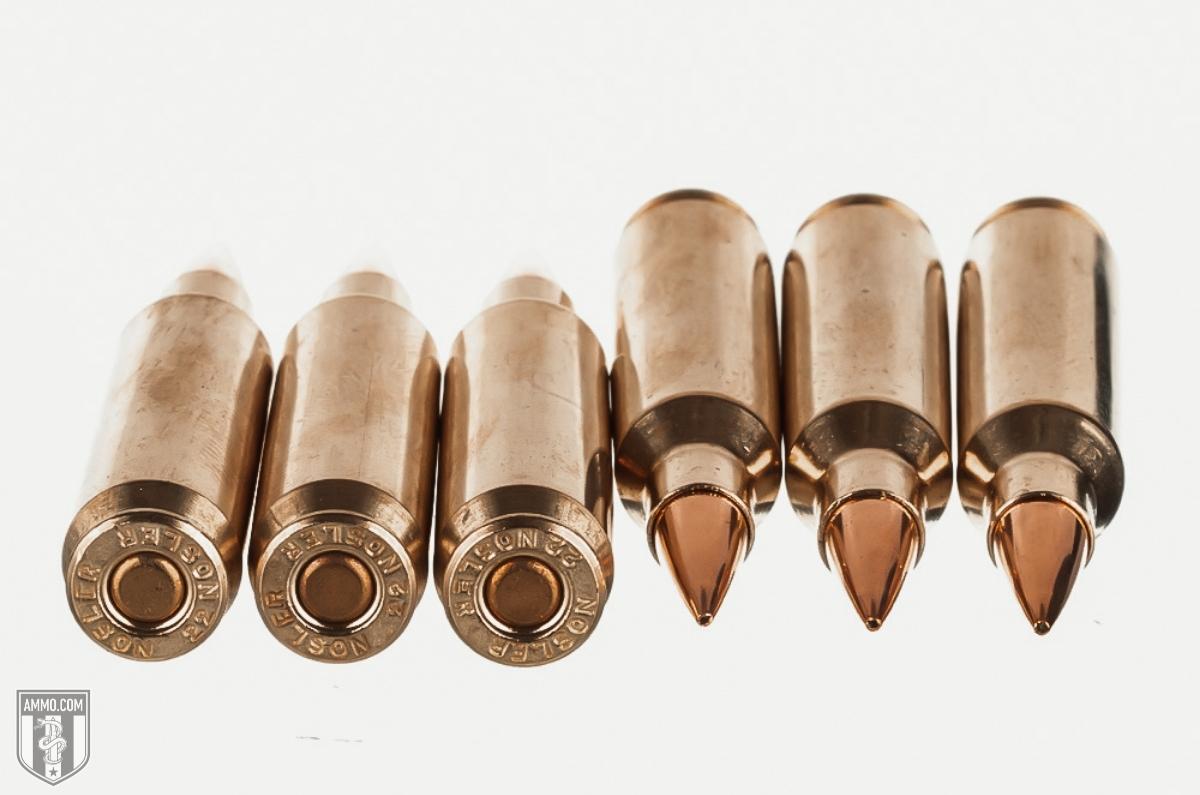
This trend continues with sectional density as the heavier bullets fired by the 22 Nosler have a higher SD than the lighter bullets fired by the 22-250. On average, 50-55 grain bullets fired by the 22-250 have a SD measuring around 0.15 while heavier options for the 22 Nosler can exceed 0.20.
Hunting
The 22-250 Remington and 22 Nosler are both excellent options for varmints and pest control.
The 22-250 has made a name for itself taking down thin-skinned varmints like woodchucks, prairie dogs, coyotes, and marmots for over 80 years. However, varmint hunters are warming up to the 22 Nosler as it offers similar ballistics to the 22-250 in the AR-15 platform.
Picking one cartridge over the other is difficult, however the 22-250 makes a better long-range hunting cartridge for smaller game thanks to its incredibly flat trajectory. Furthermore, 22-250 bolt-action rifles setup for prairie dog hunting have a 24 to 26-inch barrel to maximize muzzle velocity from the round.
The 22 Nosler is a great choice for predator hunting where you might call in multiple coyotes at the same time and you need fast follow-up shots. Typically, 20 to 24-inch barrels are used for the Nosler round.
Many shooters and internet forums have argued the concept of using a 22-caliber bullet for deer hunting. It’s a debate that we will unlikely solve in the context of this article, but those shooters who are for the 22 being used for deer would likely agree that the 22-250 makes for a poor deer hunting cartridge.
The issue with the 22-250 for deer is what makes it amazing for varmints: high velocity light bullets. Typically, when these light bullets impact a target, they are traveling so fast that they will break apart. This is great for small game like woodchucks where the fragments can do a lot of damage, but ill-suited for large game animals like deer as the fragments won’t penetrate deep enough for a clean kill.
If your state or territory allows for deer hunting with a 22-caliber cartridge, the 22 Nosler is the better choice as allows hunters to fire heavier bullets that provide the penetration needed to take a whitetail.
Ammo and Rifle Cost/Availability
As the 22-250 has been around for over 80 years, there are considerably more ammo and rifle options available for it compared to the 22 Nosler.
In terms of ammo availability, the 22-250 cannot be beat as multiple manufacturers like Winchester, Sierra, Remington, and Hornady all have multiple factory loads for the round. Inexpensive plinking ammo for the 22-250 Rem typically runs around $1.50/round while the premium long-range varmint ammo costs closer to $2.25/round.
One downside to the 22 Nosler is that other ammo manufacturers have not picked up the round for production at this time. At the time of writing, Nosler was the only manufacturer making ammo for their cartridge. Ammo typically runs around $2/round on the low end and $3/round on the high end.
When it comes to rifles, the 22-250 is typically limited to bolt-action rifles while the 22 Nosler is exclusive to the AR-15.
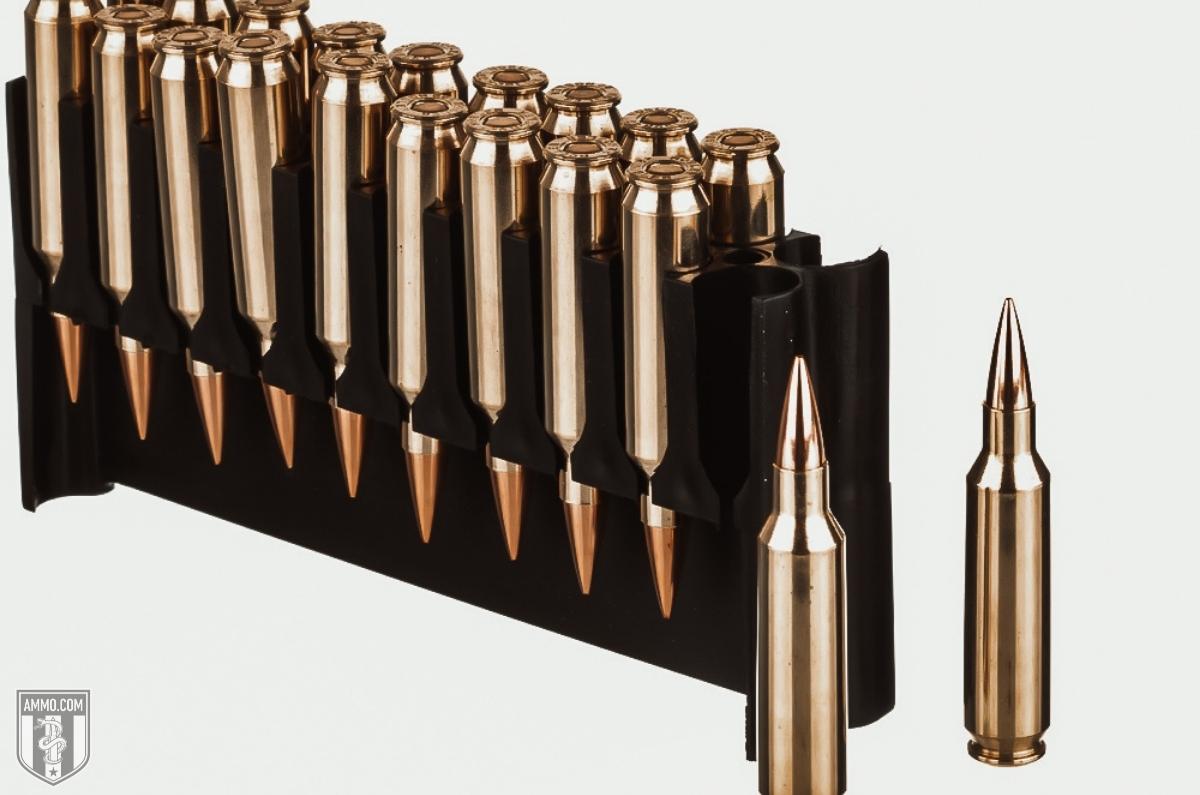
Most major rifle manufacturers have at least one offering for the 22-250, though most have more. There are budget-friendly rifles like the Mossberg Patriot, Savage Axis, and Ruger American that allow beginner hunts a solid platform to start their varmint hunting adventures with. However, if you are looking for a higher end rifle, options like the Remington 700, Winchester Model 70, Browning X-Bolt, and Savage 12 Varminter are capable of all your long-range varmint hunting needs.
For the 22 Nosler, any AR-15 on the market can easily be converted to fire the cartridge with a simple magazine change and barrel swap. As the 22 Nosler was designed with the AR-15 platform in mind, the original 5.56 NATO bolt will work and does not need to be changed. Magazines for the 22 Nosler are easy to find as the round will fit into standard 6.5 Grendel or 6.8 SPC magazines.
Reloading
If you like to handload your own ammo, both cartridges offer you a lot of options for customization in terms of projectiles and powders to make the perfect reloads for your hunting rifle.
Hunters have been handloading the 22-250 for years, and there is a plethora of load data available for the cartridge with multiple powders to suit your needs.
Although the 22 Nosler is a newcomer to the shooting community, load data is available direct from the Nosler website in popular powders like Varget, H335, BL-C(2), and Benchmark along with many others.
Bullets for both cartridges are extremely popular as the 0.224” bullet diameter is one of the most popular calibers in North America. Cartridges like the 223 Remington, 220 Swift, and 224 Valkyrie are also loaded with the same bullets, so finding surplus or inexpensive options is easy to do.
Although 22-250 factory ammo is relatively easy to find, 22 Nosler is rarer and reloading is one method that shooters use to ensure a consistent ammo supply.
Final Shots: 22-250 Remington vs 22 Nosler
The 22-250 and 22 Nosler are two rifle cartridges that represent two differing schools of thought for varmint hunting.
The 22-250 Remington has been around for nearly a century and is a classic bolt-action rifle caliber. It has been used to for years in curtailing prairie dog populations as well as being an excellent long range target shooting option.
The 22 Nosler is a newcomer to the varmint hunting family of cartridges, but it is unique as it was built specifically for the AR-15. Although 22 Nosler ballistics might not be as good as 22-250, the Nosler offers shooters semi-auto capability for multiple target engagements and fast follow-up shots.
Deciding between the 22-250 and 22 Nosler comes down to your preferred firearm. If you want to maximize the potential of a bolt-action then go with the 22-250, but if you want high-end performance out of an AR-15 then the 22 Nosler is the obvious choice.
No matter which cartridge you choose, make sure you stock up on ammunition here at Ammo.com and I’ll see you on the range!
Ammo Comparisons
- .308 vs 5.56
- 6.5 Creedmoor vs .308
- .300 Blackout vs .308
- .300 Win Mag vs .308
- .243 vs .308
- .308 vs .30-06
- 7mm-08 vs .308
- .270 vs .308
- 7.62x39 vs .308
- .223 vs .308
- .338 Lapua vs .308
- .380 ACP vs 9mm
- .223 vs 5.56
- .300 Blackout vs 5.56
- 9mm vs 45 ACP
- 9mm vs 40 S&W
- .357 SIG vs 9mm
- 10mm vs 9mm
- 9mm vs 9mm Luger
- .243 vs .270
- .300 Win Mag vs .30-06
- .270 vs .30-06
- .40 vs .45
- 38 Special vs 357
- 9mm vs 40 vs 45
- 5.56 vs 7.62x39
- 338 Lapua vs .30-06
- .30-30 vs .30-06
- 300 PRC vs 338 Lapua
- .30-06 vs 7mm
- 300 Win Mag vs 338 Lapua
- 300 PRC vs 300 Win Mag
- 300 WSM vs 300 Win Mag
- 338 Win Mag vs 338 Lapua
- 12 Gauge vs 20 Gauge
- 10mm vs 357 Mag
- .30-30 vs 7.62x39
- 224 Valkyrie vs 22-250
- 17 HMR vs 22 Mag
- 7.62x39 vs .300 Blackout
- 45 ACP vs 45 Auto
- 45-70 vs 30-30
- 300 Blackout vs 223
- 357 Magnum vs 9mm
- 350 Legend vs 300 Blackout
- 224 Valkyrie vs 223
- 45 ACP vs 38 Super
- 6.5 Grendel vs .308
- 17 HMR vs 22 LR
- 10 Gauge vs 12 Gauge
- 22-250 vs 223
- 45 Colt vs 45 ACP
- 350 Legend vs 30-30
- 5.7x28 vs 223
- 5.7 vs 9mm
- 5.56 vs 5.7
- 22 vs 9mm
- Buckshot vs Birdshot
- 450 Bushmaster vs 308
- 450 Bushmaster vs 223
- Buckshot vs Slug
- 6.5 Grendel vs 5.56 vs 223
- 6mm ARC vs 6.5 Grendel
- 44 vs 45
- 458 SOCOM vs 5.56
- 357 vs 44
- 32 ACP vs 380
- 300 Win Mag vs 338 Win Mag vs 338 Lapua Mag
- 450 Bushmaster vs 458 SOCOM vs 50 Beowulf
- 6mm Creedmoor vs 6.5 Creedmoor
- TMJ vs FMJ
- 44 Special Vs 44 Magnum
- 45 90 vs 45 70
- 6.8 Western vs 6.8 SPC
- 50 Beowulf vs 50 BMG
- 26 Nosler vs 6.5 PRC
- 28 Gauge vs 410
- 6.8 SPC vs 5.56
- 6.8 SPC vs 6.5 Grendel
- 6.8 Western vs 7mm Rem Mag vs .28 Nosler
- 6.8 Western vs 6.5 Creedmoor
- 22 Hornet vs 223
- 6.8 Western vs 6.5 PRC
- .410 vs 12 Gauge
- .410 vs 20 Gauge
- 22 LR vs 22 Mag
- 6mm ARC vs 243
- 7mm-08 vs 270
- 243 vs 6.5 Creedmoor
- Nickel vs Brass Casing
- 204 Ruger vs 223
- 50 Beowulf vs 5.56
- 260 Remington vs 6.5 Creedmoor
- 6mm Remington vs 243
- 28 Nosler vs 300 PRC
- 50 Beowulf vs 50 AE
- 22 Nosler vs 22-250
- 450 Marlin vs 45-70
- 300 Win Mag vs 300 Norma
- 458 SOCOM vs 300 Blackout
- 38-55 vs 45-70
- 22 Hornet vs 22 LR
- 300 Norma vs 338 Lapua
- 338 Lapua vs 50 BMG
- 28 Nosler vs 300 Win Mag
- 28 Nosler vs 6.5 Creedmoor
- 204 vs 22-250
- 458 SOCOM vs 45 70
- 44 40 vs 45 70
- 6.8 SPC vs 6.5 Creedmoor
- 450 Bushmaster vs 30-06
- 7mm Rem Mag vs 300 Win Mag
- 30 Carbine vs 223
- 25-06 vs 30-06
- 26 Nosler vs 28 Nosler
- 16ga vs 12ga
- 30 06 vs 7.62 x54R
- 9mm Makarov vs 9mm Luger
- 350 Legend vs 223
- 30 Carbine vs 5.56
- 6.5x55 vs 6.5 Creedmoor
- 6.5 Creedmoor vs 270 vs 25-06
- M193 vs M855
- 450 Bushmaster vs 458 SOCOM
- 6.5 Grendel vs 6.5 Creedmoor
- 350 Legend vs 5.56
- .277 Fury vs 6.8 SPC
- 277 Fury vs 300 Win Mag
- 10mm vs .45 ACP
- 277 Fury vs 223
- 6.8 SPC vs 300 Blackout
- 6.5 PRC vs 6.5 Creedmoor
- 277 Fury vs 308
- 277 Fury vs 6.5 Creedmoor
- 350 Legend vs 450 Bushmaster
- 277 Fury Vs 5.56 NATO
- 10mm vs 40S&W
- 32 ACP vs 9mm
- 32 Special vs 9mm
- 8.6 Blackout vs 300 Blackout
- 30 Super Carry vs. 9mm
- 5.56 vs 9mm
- .50 Action Express vs 9mm
- 7.62x25 vs. 9mm
- 10mm vs 44 Magnum
- 300 Blackout vs 300 Win Mag
- 6.5 Grendel vs 300 Blackout
- 460 Rowland vs 10mm
- 300 RUM vs 300 PRC
- 300 Norma vs 300 PRC
- 45 GAP vs 45 ACP
- 7mm PRC vs 300 Win Mag
- 300 PRC vs 6.5 Creedmoor
- 300 PRC vs 308
- 357 SIG vs 357 Mag
- 7.62x39 vs 7.62x51
- 243 Win vs 223 Rem
